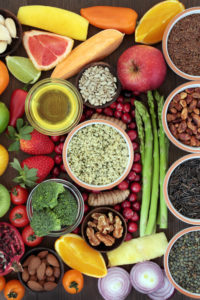High-Protein Foods: Your Best Options—and How They Keep You Healthy
You probably don’t need to be reminded, but we’ll do it anyway—don’t skimp on high-protein foods. Here’s why: Protein is a nutrient your body needs in order to maintain its structures—including muscles, bones, skin, and hair. Furthermore, protein is a key element in compounds your body needs to function properly. Consider that when you don’t get enough high-protein foods, you’re at risk for all kinds of damaging effects, from loss of muscle mass to depressed immunity to weakened cardiac and respiratory systems.
For the compelling reasons above, your daily diet should include several servings of high-protein foods, whether from meat or plant sources.
Get Your Nutrition Guide
Do you want to eat foods that help you feel better, stay slim, and avoid diet-related diseases? Do you want to be healthier by eating delicious “super” foods?
If so, claim your FREE copy, right now, of the definitive nutrition guide on living a longer, healthier, happier life.
High-Protein Foods: How Much?
The daily Recommended Dietary Allowance (RDA) for protein is 0.37 grams per pound of body weight (or 0.8 grams of protein per kilogram of body weight). To determine your protein needs, multiply your weight in pounds by 0.37. For example, if you weigh 120 pounds, that’s 44 grams of protein per day; if you weigh 160 pounds, your RDA of daily protein is 57 grams.
Newer research indicates that a slightly higher amount of protein—0.41 to 0.45 grams per pound—may be a better range for optimal health and muscle mass. Using this formula, a 120-pound adult would need 49 to 54 grams of protein per day, and a 160-pound person would need 66 to 72 grams per day. Use these numbers as a general guide; they are approximations.
Equally important to the quantity of protein you consume is the type of the protein. Below, we discuss the best protein sources.
The Protein Package
When choosing protein foods, it’s all about the protein package—the other substances and nutrients that come with the protein. Consider that some protein foods also contain undesirable ingredients—such as saturated fat, sodium, and additives—that have been linked with negative health outcomes.
For example, consuming large amounts of red meat (beef, pork, and lamb) has been linked with increased risks of heart disease, type 2 diabetes, and certain types of cancer. Processed meats, such as ham, sausage, lunch meats, and bacon, are linked with an even higher risk of these diseases. (See our post Carcinogenic Foods: Cut Them From Your Diet—and Cut Your Cancer Risk.)
GO FISH: OMEGA-3 FATTY ACIDS
What are the benefits of eating fish? First of all, fish is the major dietary source of omega-3 fatty acids—healthy fats that provide a multitude of heart health benefits. Eating omega-3-rich fish can lower your risk of arrhythmias, lower levels of triglycerides and blood pressure, and slow the growth of plaque in your arteries.
In addition, consuming omega-3s also may provide protection from:
Other protein sources come in a healthy package. For example, fatty fish offers protein packaged with healthy, unsaturated fats, including omega-3 fatty acids. Fatty fish include salmon, herring, mackerel, sardines, and albacore tuna.
The benefits of eating salmon and other fatty fish have been supported by so much research that the American Heart Association advises adults to eat at least two servings of fish, particularly fatty fish, each week. Include fish in at least two of your healthy meal plans each week.
Other high-protein foods from animal sources include other species of fish, such as haddock, trout, flounder, tuna, catfish, and bass; shellfish, including oysters, clams, scallops, and mussels; and crustaceans, including shrimp, lobster, and crab.
And be selective about your fish choices. Choose sustainable fish that are not threatened or endangered, and avoid the four fish with the highest mercury contents: shark, swordfish, tilefish, and king mackerel.
Skinless breast of chicken and turkey and low-fat milk and yogurt are other high-protein foods to include in your diet plans. And plant sources are a reliable way to get the protein you need. That includes beans, peas, nuts, and seeds, along with vegetables that should be in your diet anyway.
HIGH-PROTEIN FOODS: “VARY YOUR PROTEIN ROUTINE”
Changing things up always helps—especially when it comes to meal plans. The U.S. Department of Agriculture (USDA) offers this advice via its ChooseMyPlate.gov efforts:
- Choose seafood at least twice a week as the main protein food. Look for seafood rich in omega-3 fatty acids, such as salmon, trout, and herring. Ideas include:
- Salmon steak or filet
- Salmon loaf
- Grilled or baked trout
- Choose beans, peas, or soy products as a main dish or part of a meal often. Choices include:
- Chili with kidney or pinto beans
- Stir-fried tofu
- Split pea, lentil, minestrone, or white bean soups
- Baked beans
- Black bean enchiladas
- Garbanzo or kidney beans on a chef’s salad
- Rice and beans
- Veggie burgers
- Hummus (chickpeas spread) on pita bread
- Choose unsalted nuts as a snack, on salads, or in main dishes. Use nuts to replace (not in addition to) meat or poultry. Sample ways to include nuts:
- Use pine nuts in pesto sauce for pasta.
- Add slivered almonds to steamed vegetables.
- Add toasted peanuts or cashews to a vegetable stir fry instead of meat.
- Sprinkle a few nuts on top of low-fat ice cream or frozen yogurt.
- Add walnuts or pecans to a green salad instead of cheese or meat.
SOURCES & RESOURCES
For related reading, please visit these posts:
Originally published in 2016, this post is regularly updated.
The post High-Protein Foods: Your Best Options—and How They Keep You Healthy appeared first on University Health News.
Read Original Article: High-Protein Foods: Your Best Options—and How They Keep You Healthy »
Powered by WPeMatico


